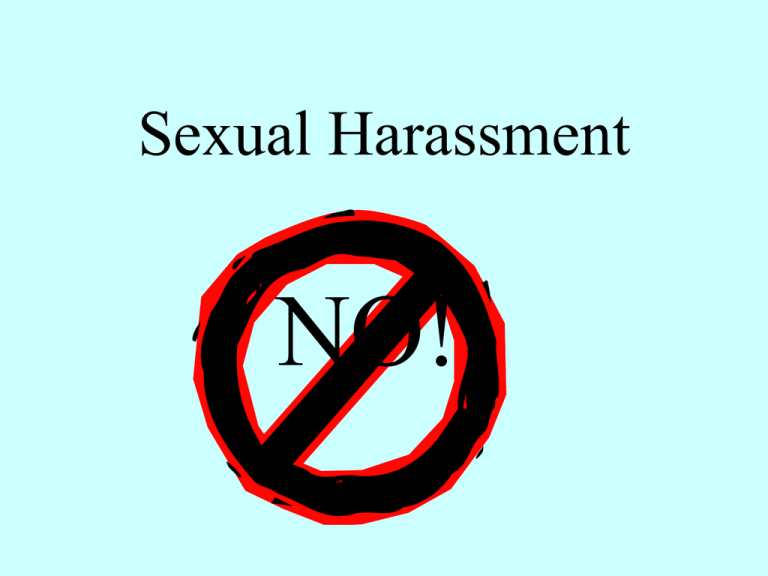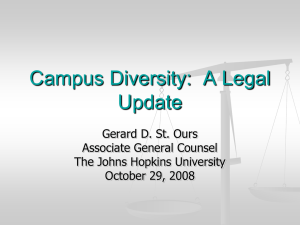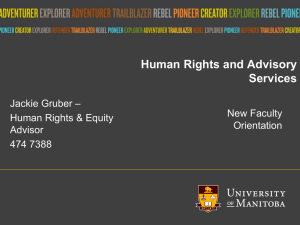
Sexual Harassment
NO!
Definition of Sexual Harassment
(from: Equal Employment Opportunity Commission
http://www.eeoc.gov/facts/fs-sex.html )
“Unwelcome sexual advances, requests for sexual
favors, and other verbal or physical conduct of a sexual
nature constitutes sexual harassment when submission
to or rejection of this conduct explicitly or implicitly
affects an individual's employment, unreasonably
interferes with an individual's work performance or
creates an intimidating, hostile or offensive work
environment.”
Sexual harassment includes a broad range
of objectionable behaviors.
These are frequently grouped into two
categories:
1. quid pro quo harassment, and
2. hostile or abusive work environment.
quid pro quo harassment
making sexual demands where refusal
results in adverse consequences (such as
dismissal, loss of promotion, reduced
benefits, etc.)
a hostile or abusive work environment
actions that are sufficiently offensive to
result in a hostile or abusive work
environment
A hostile or abusive environment is one
that a reasonable person would perceive
to be such.
Evidence of severe psychological injury
or diminished job performance is not
necessary.
According to the E.E.O.C.
(http://www.eeoc.gov/facts/fs-sex.html),
sexual harassment can occur in a variety of
circumstances, including but not limited to the following:
1. The victim as well as the harasser may be a
woman or a man. The victim does not have to be
of the opposite sex.
2. The harasser can be the victim's supervisor, an
agent of the employer, a supervisor in another
area, a co-worker, or a non-employee.
3. The victim does not have to be the person
harassed but could be anyone affected by the
offensive conduct.
4. Unlawful sexual harassment may occur without
economic injury to or discharge of the victim.
5. The harasser's conduct must be unwelcome.
The number of charges of sexual harassment
resolved by the E.E.O.C. were….
for fiscal year 2011: 12,571; and
for each fiscal year between 1997 and 2010:
between 11,592 and 17,333.
( http://www.eeoc.gov/eeoc/statistics/enforcement/sexual_harassment.cfm )
U.S. studies report the following percentages of
individuals have experienced sexual harassment:
Women: 40 to 75 %
Men:
13 to 31 %
Employers bear responsibility for
preventing and eliminating sexual
harassment from the workplace.
An employer is liable when sexual harassment
results in “a tangible employment action such as
discharge, demotion or undesirable assignment.”
When there is no tangible action (as in hostile
environment cases), an employer could still be
liable, but could defend itself by establishing that
1. “reasonable care to prevent and correct
promptly any sexually harassing behavior”
has been taken, and
2. the employee “unreasonably failed to take
advantage of any preventive or corrective
opportunities” provided.
A strong, well-publicized employer policy against
harassment combined with an effective grievance
procedure are the best tools for employers to
combat sexual harassment and to protect
themselves from liability.
In particular,
1. the policy must be effectively
communicated to employees,
2. complaints must be promptly
investigated, and
3. appropriate corrective action
must be promptly taken.
Sexual Harassment Training
People need regular, effective training. A
30-minute briefing is not sufficient. Even if
employees have read the company’s policy
on sexual harassment, they tend to forget
key points and need refreshers.
Goals of Sexual Harassment Training
Raise awareness and clarify misconceptions
about what constitutes sexual harassment.
Inform managers of their responsibilities to
provide a harassment-free work environment
for all employees.
Sexual harassment is not limited to
private sector business.
The U.S. military has also been found to
have significant problems with sexual
harassment.
In addition to the effects on the victim, there
are many costs incurred by an organization as
a consequence of sexual harassment.
The expenses from law suits are only one set
of costs.
When an individual leaves his/her place of
employment because of harassment, the
replacement costs can be quite high, and
include expenditures for recruitment and
retraining.
Negative publicity is another cost of sexual
harassment.
A group of researchers created a model
involving sexual harassment.
They explored the factors related to
the existence of sexual harassment as
well as the consequences of that
harassment.
A Model of the Antecedents and Consequences
of Workplace Sexual Harassment
From: C. R. Willness, P. Steel, and K. Lee. (2007). A meta-analysis of the antecedents and
consequences of workplace sexual harassment. Personnel Psychology, 60, 127–162.
A Model of the Antecedents and Consequences
of Workplace Sexual Harassment
Sexual harassment is more likely to be a problem when certain
aspects of the organizational climate exist. These aspects include:
(a) Perceived risk to victims for complaining,
(b) Lack of sanctions against offenders, and
(c) Perception that complaints will not be taken seriously.
A Model of the Antecedents and Consequences
of Workplace Sexual Harassment
Job gender context is usually measured by the gender ratio of the workgroup,
and/or the extent to which an occupation is traditionally male or traditionally
female.
Incidents of sexual harassment tend to be more prevalent in:
(a) work groups where women represent the minority, and
(b) situations where women are working in traditionally “masculine” occupations.
A Model of the Antecedents and Consequences
of Workplace Sexual Harassment
Job-related consequences of sexual harassment include:
(a) reduced satisfaction with coworkers, supervisor, and the job;
(b) reduced organizational commitment and increased withdrawal behavior
such as absenteeism; and
(c) reduced workgroup productivity (quantity and quality of work produced).
A Model of the Antecedents and Consequences
of Workplace Sexual Harassment
Effects on the health and well-being of the sexual harassment victim may include:
(a) adverse psychological effects such as anxiety, depression, and post-traumatic
stress disorder (symptoms of which include emotional numbing, flashbacks,
and sleep disturbances);
(b) physical health symptoms such as nausea, headaches, shortness of breath, and
exhaustion;
(c) reduced overall life satisfaction.
Serious negative consequences of sexual
harassment have been found to be evident
across socioeconomic groups, educational
levels, cultures, countries, age groups, and
occupations.
Sexual orientation harassment is
also a serious problem.
Human resource professionals and other
business people should be aware of the fear
that gay employees feel about coming out.
Gays fear the impact of coming out on their
physical safety, opportunities for promotion,
merit ratings, salary increases, and team
cohesiveness.
Numerous studies have collected survey data on
discrimination and harassment against lesbians,
gays, bisexuals, and transgender individuals.
The results have been compiled in:
Badgett, M.V.L., Lau, H., Sears, B., and Ho, D.,
(2007). Bias in the Workplace: Consistent Evidence
of Sexual Orientation and Gender Identity
Discrimination. Los Angeles: Williams Institute,
http://www.escholarship.org/uc/item/5h3731xr .
In the two slides that follow, some of the findings are
summarized.
Studies done since the mid-1990s have found that
15% to 43% of lesbian, gay, or bisexual (LGB)
respondents experienced discrimination in the
workplace.
More specifically, LGB respondents reported the
following experiences related to their sexual
orientation:
(a) 8%-17% were fired or denied employment,
(b) 10%-28% were denied a promotion or given
negative performance evaluations, and
(c) 7%-41% were verbally or physically abused or
had their workplace vandalized.
In several studies conducted between 1996 and 2006,
20% to 57% of transgender respondents reported
having experienced employment discrimination at
some point in their life.
More specifically, based on their gender identity,
(a) 13%-56% were fired,
(b) 13%-47% were denied employment,
(c) 19% were denied a promotion, and
(d) 22%-31% were harassed.







